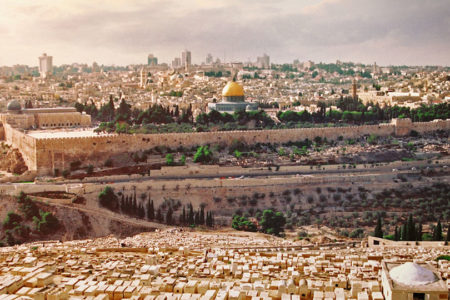The Oppression Of Middle East Christians
A Forgotten Tragedy
Extraordinary diplomatic efforts in recent years have been undertaken to resolve some of the world’s most complex, divisive conflicts—in Ireland, Bosnia, and the Middle East. The latter is no closer to resolution. In the troubled Middle East, Islamic fundamentalism, which is seeking to reignite the Arab-Israeli conflict, is targeting Christians, Jews, and other non-Moslems throughout the Islamic world.
Middle East Christians: Location and Numbers
Egypt: The Copts of Egypt—Orthodox, Catholics, and Protestants—are estimated to be between 10 and 12 million, dispersed across the country. They are the descendants of the ancient Egyptian people living under the Pharaohs. Their numbers shrank after the Arab-Moslem invasion in 740 A.D. and flourished under the British in the 19th century. One million Copts live in the diaspora, particularly in the United States and Canada.
Sudan: Seven million black Africans live in the south. Most of these tribes are Christians—Anglicans, other Protestants, and Catholics. After the Islamic conquest, the Africans of Nubia were displaced to the south. Since the Islamist takeover in the north in 1989, they have been submitted to ethnic cleansing and forced to abandon their faith in order to protect their lives. One million south Sudanese are living in exile.
Lebanon: The Christians—Maronites, Orthodox, Melkites, and other communities, including Protestants—number about 1.5 million. Since 1975, hundreds of thousands have been massacred, displaced, and exiled. Since 1990, the Christian areas of Lebanon have been under Syrian occupation. There are more than 7 million Lebanese Christians in the diaspora. More than 1.5 million Americans are of Lebanese descent.
Iraq: About 1 million Christian Assyrians, Nestorians (Orthodox), Chaldeans (Catholics), and others (Evangelicals, Jacobites) live in Iraq. Most of the Christians are concentrated in the north. The Assyrians are submitted to cultural and political repression. Approximately 1 million Christian Mesopotamians live in North America, Europe, and Australia.
Syria: One million Christians are Syrian citizens. Deprived of their cultural and educational rights, Syria’s Aramaeans, Armenians, Orthodox, and Melkites are present in the northeast and in the major cities.
Iran: Five hundred thousand Persian, Armenian, and Assyrian Christians from all denominations live in constant fear under the Islamic Republic of Iran. Christian spiritual leaders are executed by the government.
Middle East Christians Under Attack
In Lebanon, where Christians enjoyed constitutionally guaranteed parity until a few years ago, hundreds of Christians have been and continue to be arrested, tortured, and jailed by pro-Syrian forces. In the south of Lebanon, thousands of Christians are bombarded constantly by Hizbullah. In the event of an Israeli withdrawal, the Christian community will be threatened by Islamist militias.
Similarly, dozens of Christian villages in Egypt are routinely attacked by the Islamists. For example, the village of Manshiet Nassr in Upper Egypt has been attacked by Islamic fundamentalists repetitively. Dozens of Christians have been killed or injured.
Today, South Sudanese Christians are being killed by the Islamist forces of Khartoum. Entire villages are being destroyed by the Arab government of the north. Yet these tragedies, like many others in the Moslem world, go unreported by the Western media and unchallenged by Western leaders.
These examples are not isolated events, nor is the neglect they receive from the press and world governments. Thus, the public in the United States is largely unaware of the “Middle East” that non-Moslems of the region know all too well. Non-Moslems are targeted by Islamic fundamentalists, who are tacitly encouraged by governments of the region—governments who, at best, do nothing to stop them and, at worst, actively lead the pogroms.
The Collective Suffering
Middle East Christians suffer collectively, yet few people in the West are aware of the size of the Christian communities in the Middle East. The common image of Middle Eastern Christianity is that it is limited to a few groups or individuals among the Palestinian population. In reality, the Palestinian Christians are only a fragment of the millions of Christians from Sudan to Armenia. More than 10 million Copts live in Egypt, 7 million Christians and Animists in South Sudan, 1.5 million Christians in Lebanon, approximately 1 million Assyro-Chaldeans in Iraq, 1 million Christians in Syria, and 500,000 in Iran, among others.
The fact is that the Middle East is not entirely Arab nor entirely Moslem. The Arab-Israeli confrontation is not the only conflict in the Middle East. Centuries earlier, a major invasion occurred from Arabia, which ushered in domination by Arabs and Moslems in Syria, Mesopotamia, Palestine, and Egypt. Gradually the new conquerors attempted to assimilate millions of Christians, attempting to transform the conquered nations into “Arabized” and “Islamized” populations. Those who were not assimilated by the Arabs became second-class citizens called the “dhimmis” and were deprived of their basic political, social, and economic rights.
Survival and Rights
Despite the continuous oppression of these Middle Eastern communities for 13 centuries, many national groups survived and struggled to restore their freedom. Around the beginning of this century, the Copts of Egypt, the Assyro-Chaldeans of Iraq, the South Sudanese, and the Lebanese Christians tried to obtain independence. But the Arab powers in the region denied these Christians their natural right of self-determination. At the expense of the Middle East Christians, Arab identity and Islamic domination were established in the region.
The Impact of Israel
The creation of the State of Israel was perceived as a major positive development in the eyes of other non-Arabs. Indeed, the Middle East Christians considered the rebirth of Israel and the regathering of the Jewish people in their historic land as a promise of their own future liberation. The Jewish success demonstrated that Christians could achieve similar goals.
For decades, secretly or openly, Christians from countries including Lebanon, Iraq, and Sudan have praised the Israeli model and attempted to imitate it. This attraction between Israel and the Middle East Christians challenged the Arab-Islamic order in the region.
The Arabist Strategy
In reaction to the Jewish state, the Arabist strategy since the 1940s has been the following:
- To claim that the Middle East is an Arab and Moslem region. This claim is directed not only at Israel, but at all non-Arab, non-Moslem populations in the region.
- To separate non-Arab, non-Moslem groups from one another.
- To eliminate the minorities within their borders, by one means or another.
This strategy has been in effect in the Middle East for decades. The Assyrians were massacred in Iraq, then in South Sudan, followed by the Christians in Lebanon and the Copts in Egypt.
For example, in 1982 the Arabs applied overwhelming pressure on the United States and Western governments and used all of their influence to abort any agreement between Lebanon and Israel. This episode was followed by the massacre of thousands of Lebanese Christians throughout the 1980s and the invasion of their free enclave in 1990.
It should also be noted that the Arabist strategy has carefully included a misinformation campaign in the United States. Throughout the war, which dragged on for a decade and a half, the “Arabs” were wrongly referred to by the press as a collective group and routinely portrayed as the victims. Israel was the “aggressor,” whereas the Syrians were carelessly called “peacekeepers” by too many.
Even worse, the public has been all too often misled by Middle Eastern Christians, usually from Lebanese descent, who have historically been the leaders of the Arab lobbies in this country. These individuals, who do not represent the causes of their motherland, perpetuated the interpretation (and sometimes even advocated the demands) of the Arabists, both in the region and in the United States.
Another trend was to block favorable American policies toward the Christians of the Middle East and toward Israel, within the administration and throughout the various bodies of the U. S. government. More particularly, efforts were aimed at destroying any attempt to build bridges between the Middle Eastern (specifically Lebanese) Christians and the Jewish community. The Arab lobby also waged several campaigns to discredit the Middle East Christians.
The Middle East’s Christian Strategy
Since its inception, the Middle East Christian Committee (MECHRIC) has advanced the following strategy as a way to rebuild the legitimacy of the Christian cause in the Middle East:
- To confront the Islamist strategy through alliance. This effort is currently aimed at building a coalition of Copts, Lebanese Christians, Assyrians, and South Sudanese, in order to represent these forgotten Christian nations. Since 1992, the MECHRIC has spoken on behalf of these resistance movements in the diaspora.
- To reach the American, European, and worldwide Christian public and involve them in supporting the struggle of Middle Eastern Christians.
- To build an open and historical alliance between American and Middle East Christians on the one hand, and American Jews and Israelis on the other hand. This union could offer testimony that could help to expose the Islamists’ falsifications and lay the grounds for the emergence of a free and democratic Middle East, which includes and protects all of its nations and in which the Christian peoples of the Middle East, the Jews of Israel, and the Arab Moslems can live in harmony.
Editor’s Note: In this article, the author uses the word Christian in a broad sense to distinguish non-Moslem communities who profess Christianity and are therefore marked for persecution by radical Islamic groups.








